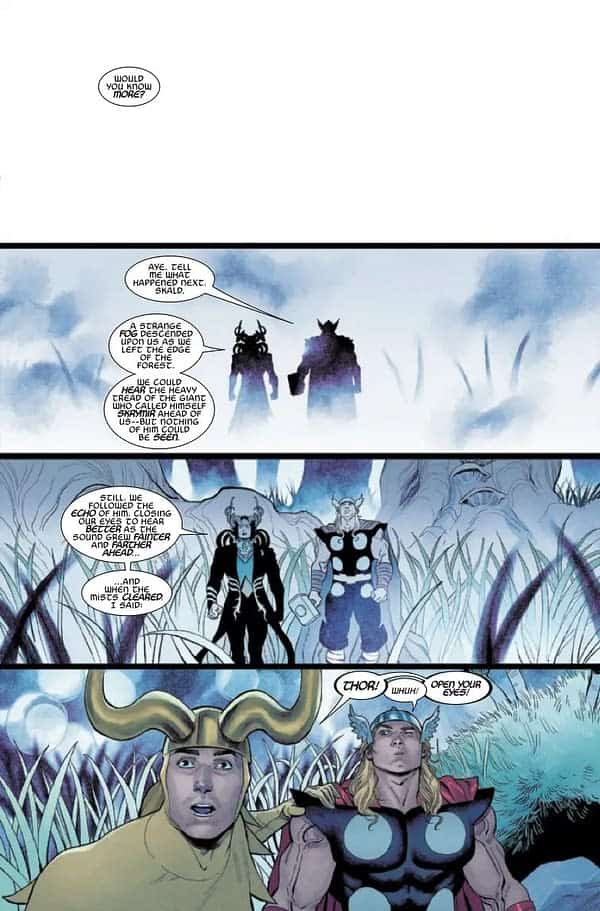Immortal Thor #7

Recap
In Immortal Thor #6, Loki began telling Thor a story from their youth - which some may recognise from a book of Norse mythology. In the past, Loki and Thor encounter the giant Skrymir and travel to the home of Utgard-Loki: Utgard. In the present, the villains Amora, Skurge, and Dario Agger are gathered reading the comic itself, just as Loki has told it. Probably nothing we need to worry about, though.
Review
“Would you know more?” asks Loki in the opening line of Immortal Thor #7. Thor and readers alike are invited to journey further into the Norse myth Gylfaginning, in which Thor and Loki travel to Utgard and meet Utgard-Loki.
And like all myths, this tale has many tellers and many listeners. In Gylfaginning, Loki’s question and the tale attached to it were told by a disguised Odin to the Scandinavian king Gylfi. And as Loki now tells the tale to Thor, the villains Dario Agger, Amora, and Skurge are reading along, no doubt with their own (metafictional) plans up their evil sleeves.

In reality, Gylfaginning was a tale first passed down orally, then written down by Icelandic scholar Snorri Sturluson in the twelfth century. Eventually, it was translated into English by numerous translators. And tellers working from those translations brought Gylfaginning to Marvel Comics in 1978’s Thor #272. And here, we find Gylfaginning (and Thor #272) retold once more: by Al Ewing, Martín Cóccolo, Matt Wilson, and Joe Sabino. And every teller brings something of their own to the story.

Immortal Thor #7 offers an enchanting first encounter with the material for new readers. Al Ewing’s narration and dialogue deftly balance the original myth’s cleverness and comedy without sacrificing its weirdness and darkness. Readers familiar with the myth, however, can continue to find fun in seeing the changes these new tellers have made to the tale. Cóccolo’s artwork continues to capture the comedy in Ewing’s script and, crucially, the sense of terrifying scale when Thor and Loki walk into the castle of Utgard and meet its lord. Cóccolo’s design for Utgard-Loki, heretofore seen only in glimpses, is a surreal, skeletal figure who seems at times interchangeable with the architecture of Utgard itself. As Utgard-Loki sets Thor and Loki a series of tests, Cóccolo’s artwork grows increasingly surreal, though never quite to the extent seen in Alex Ross’ mind-bending cover. Wilson’s colors bring warmth and life to Cóccolo’s work, along with the occasional clever-though-unexpected choice. (In my mind, the cat in Gylfaginning was never green.) The twists introduced by this new generation of storytellers may leave even more informed readers guessing. Now more than ever, the only conceivable answer to the question “Would you know more?” is an emphatic yes.
Final Thoughts
Immortal Thor #7 reminds us that storytelling at its best is a form of magic.
Immortal Thor #7: Would You Know More?
- Writing - 10/1010/10
- Storyline - 10/1010/10
- Art - 10/1010/10
- Color - 10/1010/10
- Cover Art - 10/1010/10





